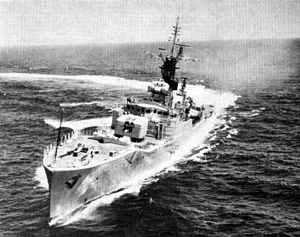HMS Torquay (F43)
 |
|
| History | |
|---|---|
|
|
|
| Name: | HMS Torquay |
| Ordered: | 6 March 1951 |
| Builder: | Harland and Wolff |
| Laid down: | 11 March 1953 |
| Launched: | 1 July 1954 |
| Commissioned: | 10 May 1956 |
| Decommissioned: | 23 March 1985 |
| Identification: | Pennant number: F43 |
| Fate: | Scrapped 1987 |
| General characteristics | |
| Class and type: | Whitby-class frigate |
| Displacement: | |
| Length: | |
| Beam: | 41 ft (12.5 m) |
| Draught: | 17 ft (5.18 m) |
| Propulsion: | Y-100 plant; 2 Babcock & Wilcox boilers, 2 English Electric steam turbines, 2 shafts, 30,000 shp (22 MW) |
| Speed: | 30 kn (56 km/h) |
| Range: | 370 tons oil fuel, 4,200 nmi (7,780 km) at 12 knots (22 km/h) |
| Complement: | 152, later 225 |
| Sensors and processing systems: |
|
| Armament: |
|
|
|
|
|
|
HMS Torquay was a Type 12 Whitby-class frigate of the British Royal Navy. They were the first frigates to have the "V" form hull. This evolutionary design made it possible to be driven in head sea without the usual slamming which occurs with conventional destroyers of the time. Each frigate cost 3.5 million pounds and the first ship completed was Torquay in May 1956.
Torquay was launched by Lady Monkton on 1 July 1954, and participated in the Suez operation in 1956. In 1958 she was diverted to Tobruk following the assassination of the Iraqi Royal Family.
Between 1967–1971 Torquay was one of the frigates allocated to the Dartmouth Training Squadron and between 1972–1985 Torquay served as a navigation training ship based in Portsmouth. In 1971 the ship was refitted with a solid main mast (as opposed to a lattice mast) and a large training navigation room was built where the forward set of triple-barrelled mortars used to be located (leaving one set of mortars). She was also fitted to undertake trials of CAAIS (Computer Assisted Action Information System). Torquay attended the 1977 Silver Jubilee Fleet Review off Spithead when she was part of the 2nd Frigate Squadron.
Replaced by the Leander-class frigate Juno as the navigation training vessel for the Royal Navy, Torquay paid off on 23 March 1985. At the time she was the longest serving ship of her class and the oldest frigate in the fleet. She was sold for scrap in 1987 and left Portsmouth on 1 July 1987 to be broken up in Barcelona, Spain.
...
Wikipedia
